
NCERT Solutions Class 7 Social Science Geography Chapter 6: Natural Vegetation and Wildlife, here we are going to give you a summary of Class 7 Social Science Geography Chapter 6: Natural Vegetation and Wildlife with questions and answers from the textbook. In this chapter we will study about the different types of vegetation and wildlife and how various factors affect them. Your all doubts from the chapter of NCERT Solutions for Class 7 Social Science Geography Chapter 6: Natural Vegetation and Wildlife of class 7 NCERT will be cleared from these explanations.
Read more: NCERT Solutions For Class 7 Social Science Geography Chapter 3 Our Changing Earth
NCERT Solutions Class 7 Social Science Geography Chapter 6: Natural Vegetation and Wildlife : Introduction
There is a close relationship between height of land and the character of vegetations. With the change in height, the climate changes and that changes natural vegetation.
The growth of vegetation depends on:
- Temperature
- Moisture
- Slope
- Thickness of soil.
Difference in vegetation is due to difference in these factors
Different types of natural vegetation
There are three broad categories of natural vegetation as follows:
- Forests: They grow where temperature and rainfall are plentiful to support a tree cover.
- Grasslands: They grow in the region of moderate rain.
- Shrubs: They grow in the dry region.
Note: Himalayas have almost all variety of vegetation which one can see while moving from the equator to the polar region.
The changes in the type of natural vegetation occur mainly because of the changes of climatic condition.
Different types of natural vegetation of the world with their characteristic features and wildlife inhabiting there:
FORESTS
Tropical Evergreen Forests
- Also called tropical rainforests.
- Occur in regions near equator and close to the tropics.
- Hot throughout the year
- Heavy rainfall throughout the year
- No particular dry season
- Trees do not shed their leaves altogether (evergreen)
- Thick canopies of the closely spaced trees do not allow the sunlight to penetrate inside the forest even in the day time.
- Trees such as rosewood, ebony, mahogany are common.
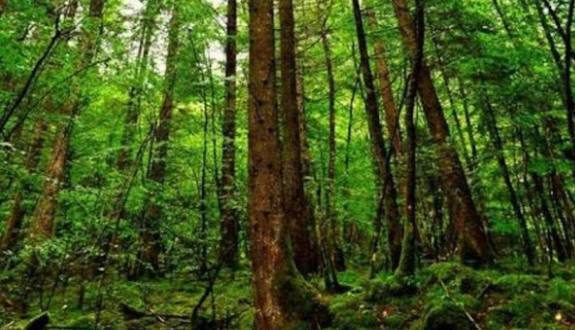
Tropical Deciduous Forests
- Also called monsoon forests
- Found in large part of India,northern Australia and in central America
- They experience seasonal changes.
- Trees shed their leaves in the dry season to conserve water.
- Trees such as sal, teak, neem and shisham are common.
- Tigers, lions, elephants, langoors and monkeys are common animals here.
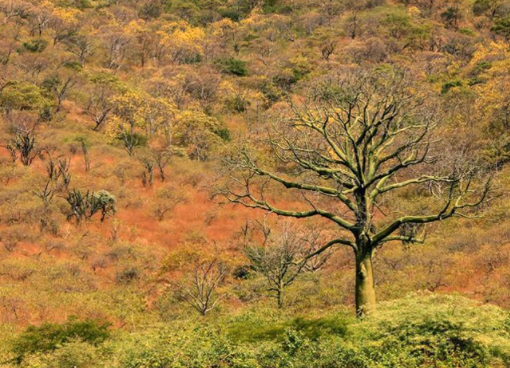
Temperate Evergreen Forests
- Located in the mid-latitudinal coastal region
- Commonly found along the eastern margin of the continents for example in south east USA, South China and in South East Brazil.
- Trees such as oak, pine, eucalyptus, etc. are common.
Temperate Deciduous Forests
- Found in higher latitudes.
- Found in the north eastern part of USA, China, New Zealand, Chile and also found in the coastal regions of Western Europe.
- The trees here shed their leaves in the dry season.
- Trees such as oak, ash, beech, etc. are common.
- Deer, foxes, wolves are common animals here.
- Birds like pheasants, monals are also common here
Mediterranean Vegetation
- Found in the west and south west margins of the continents.
- Found in the areas around the Mediterranean sea in Europe, Africa and Asia
- They are also found outside the actual Mediterranean region in California in the USA, south west Africa, south western South America and South west Australia
- They have hot dry summers and mild rainy winters
- Citrus fruits such as oranges, figs, olives and grapes are commonly cultivated here. People have removed the natural vegetation in order to cultivate what they want to.
- Not much wildlife is found here.
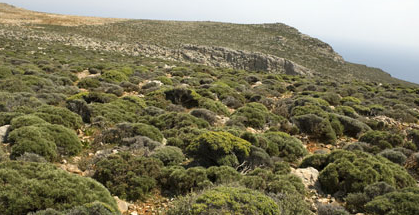
Coniferous Forests
- Found in higher latitudes (50° – 70°) of Northern hemisphere
- Also called as Taiga
- Also found in the higher altitudes
- Trees such as chir, pine, cedar are common.
- Silver fox, mink, polar bear are common animals here.
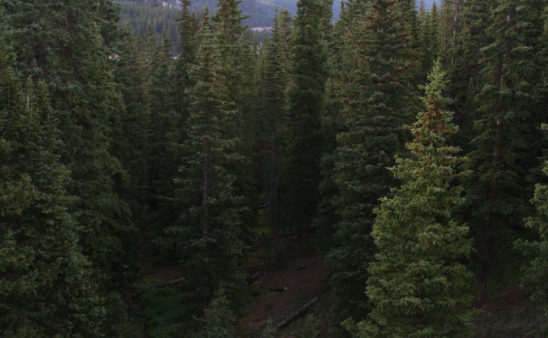
GRASSLANDS
1. Tropical grasslands
- They occur on either side of the equator and extend till the tropics
- Found in the areas of moderate to low amounts of rainfall.
- The grass can grow very tall (3-4m)
- Elephants, zebras, giraffes, deer, leopards are common animals here.
- Savannah grasslands of Africa are of this type
2. Temperate grasslands
- Found in the mid latitudinal zones and in the interior part of the continents.
- Grass here is short and nutritious.
- Wild buffaloes, bisons, antilopes are common animals here.
3. Thorny bushes
- Found in the dry desert like regions
- Located on the western margins of the continents
- Vegetation cover is scarce
- Scanty rain is present
- Scorching heat is present
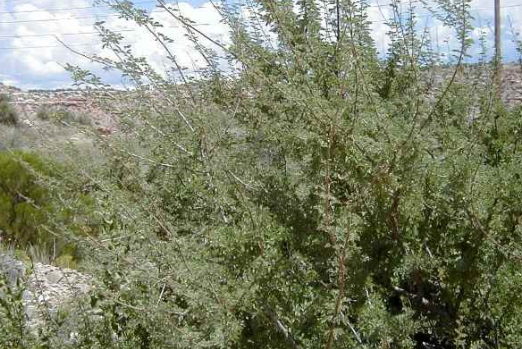
Tundra
- Found in polar region
- Extremely cold place
- Growth of natural vegetation is very limited
- Mosses, lichens and very small shrubs are found here
- Grows during the very short summer
- Found in polar areas of Europe, Asia and North America
- Animals have thick fur and thick skin to protect themselves from the cold climatic conditions.
- Seal, walruses, musk-oxen, Arctic owl, Polar bear and snow foxes are common animals here.
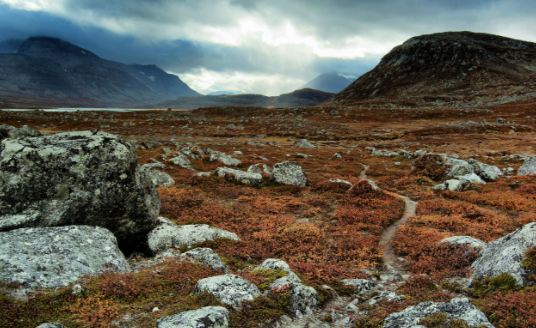
NCERT Solutions for Class 7 Social Science Geography Chapter 6: Natural Vegetation and Wildlife : Exercises
1. Answer the following questions.
(i) Which are the two factors on which the growth of vegetation mostly depends?
Ans. The growth of vegetation mostly depends on:
- Climate
- Soil
(ii) Which are the three broad categories of natural vegetation?
Ans. The three broad categories of natural vegetation are:
- Forests
- Grasslands
- Shrubs
(iii) Name the two hardwood trees commonly found in tropical evergreen forest.
Ans. Rosewood and Mahogany
(iv) In which part of the world are tropical deciduous forests found?
Ans. They are found in large part of India,northern Australia and in central America
(v) In which climatic conditions are citrus fruits cultivated?
Ans. Mediterranean Vegetation climate
(vi) Mention the uses of coniferous forest.
Ans. Uses of coniferous forest are:
- Manufacturing paper and newsprint
- Match boxes are made
- Packing boxes are made
(vii) In which part of the world is seasonal grassland found?
Ans. Seasonal grasslands are found in mid latitudinal zones or the temperate areas of the world.
2. Tick the correct answer.
(i) Mosses and Lichens are found in:
(a) Desertic Vegetation (b) Tropical evergreen forest (c) Tundra vegetation
Ans. (c) Tundra vegetation
(ii) Thorny bushes are found in:
(a) Hot and humid tropical climate (b) Hot and dry desertic climate (c) Cold polar climate
Ans. (b) Hot and dry desertic climate
(iii) In tropical evergreen forest, one of the common animals is:
(a) Monkey (b) Girraffe (c) Camel
Ans. (a) Monkey
(iv) One important variety of coniferous forest is:
(a) Rosewood (b) Pine (c) Teak
Ans. (b) Pine
(v) Steppe grassland is found in
(a) S. Africa (b) Australia (c) Central Asia
Ans. (c) Central Asia
3. Match the following.
| COLUMN I | COLUMN II |
| (i) Walrus | (a) Soft wood tree |
| (ii) Cedar | (b) An animal of tropical deciduous forest |
| iii) Olives | (c) A polar animal |
| (iv) Elephants | (d) Temperate grassland in Australia |
| (v) Campos | (e) Thorny shrubs |
| (vi) Downs | (f) A citrus fruit |
| (g) Tropical grassland of Brazil |
| COLUMN I | COLUMN II |
| (i) Walrus | (c) A polar animal |
| (ii) Cedar | (a) Soft wood tree |
| iii) Olives | (f) A citrus fruit |
| (iv) Elephants | (b) An animal of tropical deciduous forest |
| (v) Campos | (g) Tropical grassland of Brazil |
| (vi) Downs | (d) Temperate grassland in Australia |
4. Give reasons.
(i) The animals in polar region have thick fur and thick skin.
Ans. In polar region has thick fur and thick skin.because of the cold climatic conditions.
(ii) Tropical deciduous trees shed their leaves in the dry season.
Ans. Tropical deciduous trees shed their leaves in the dry season to reduce water loss because of less rainfall during winter.
(iii) The type and thickness of vegetation changes from place to place.
Ans. The type and thickness of vegetation changes from place to place because the plants need to adapt themselves to different climatic and soil conditions.
NCERT Solutions for Class 7 Social Science Geography Chapter 6: Natural Vegetation and Wildlife : Conclusion
In conclusion to NCERT Solutions for Class 7 Social Science Geography Chapter 6: Natural Vegetation and Wildlife we have learnt a lot about natural vegetation and wildlife. We have learnt about how climate and other factors affect it and many more things. NCERT Solutions for Class 7 Social Science Geography Chapter 6: Natural Vegetation and Wildlife teaches us that animals and plants that is all living beings adapt to their surroundings. Every living being is different from one another and thus they are important to keep an ecosystem thriving. Depletion of one species leads to many complications and thus, we should ensure that everyone is in harmony and peace. NCERT Solutions for Class 7 Social Science Geography Chapter 6: Natural Vegetation and Wildlife ends here, we will study more in further classes.